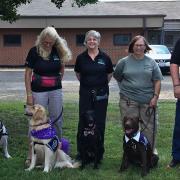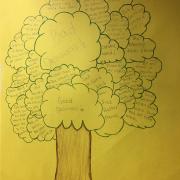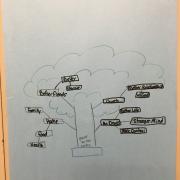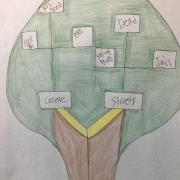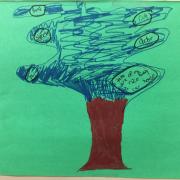Our library partnered with Got Your Six Support Dogs to create a program for teens and tweens at the Madison County Juvenile Detention Center. We were already leading a book club for students at the detention center as part of ALA’s Great Stories Club program.
Therapy dogs were brought in for two discussions of change and decision-making based on Sherman Alexie’s “The Absolutely True Diary of a Part-Time Indian.” Afterwards, the students spent time thinking about their lives and goals by making "decision trees."
Advanced Planning
This program came together in sections. In spring 2016, we were selected to be part of the Great Stories Club, a book club program for at-risk teens created by ALA’s Public Programs Office. As part of our proposal for the program, we would be partnering with the Madison County Juvenile Detention Center to read and discuss several books that deal with the theme of “The Art of Change: Creation, Growth and Transformation.”
We began seeking a partner to make sessions more relatable to the youth. I met a group of therapy dogs and their owners from Got Your Six in August 2016 and thought, why not try and take them to the detention center? The staff and administrators at the center welcomed the opportunity to introduce therapy dogs to their incarcerated youth population because of the proven physical and emotional benefits.
Numerous scientific studies performed over the past 25 years support the belief that therapy animals reduce stress, decrease loneliness and depression, and facilitate social interactions among people. All of these factors are prevalent in any center with incarcerated youth who are separated from family, friends and their own pets. It made sense to try to alleviate some of the stress during the book talks, and the dogs make that happen. The room changes from a captive audience of participants to a group of teens and tweens who are interacting with the dogs and with me in a relaxed and receptive mood. The book talk is no longer about answering questions; it becomes a place where the students are relaxed enough to share insights into their worlds that they would not share with me under normal classroom circumstances.
Marketing
There are two classrooms in the detention center, and one of the teachers agreed to partner with us as part of the Great Stories Club grant. We had a guaranteed group of classroom students for the book discussions and did not market the program to outside participants because access to the building is restricted. We did put up posters in the classroom, and the students were told that we would meet when they were halfway through “The Absolutely True Diary of a Part-Time Indian,” and we would come back again when they finished to complete the book talk. The therapy dogs attended both sessions and were the perfect way to illustrate how decisions in life lead to change.
Four of the five dogs in attendance were shelter dogs, which fit well into the Mutt-i-grees curriculum, which highlights the importance of caring for and adopting animals from shelters as an alternative to buying purebreds. The curriculum introduces humane education and social and emotional learning into groups of youth with the goal of fostering empathetic, compassionate and responsible decision-making. All these elements are valuable life skills for students at the center who, because of their own life experiences, may lack the skills to make good decisions.
Budgeting
The budget for this program was pretty minimal. Our Junior Friends of the Library group helped out with the small amount of funding, about $50, needed to buy snacks for the group. The books that the students read were provided as part of the Great Stories Club grant.
Day-of-event Activity
We had our mid-book discussion for “The Absolutely True Diary of a Part-Time Indian” on Aug. 29, 2016, and it was so moving. We brought our therapy dog partners into the juvenile detention center for the meeting, where we talked about Sherman Alexie’s character and the courage and effort it took to start changing his life. We then discussed the changes that can happen to a dog that is placed in a shelter and the positive change that occurs when it is adopted and finds a new life’s purpose as an assistance or therapy dog.
Finally, when the barriers were down, I was able to start my art project. I had poster board and markers and asked for a volunteer to share an example of someone they knew who had made a change in their lives that was for the positive. One young man spoke of his cousin, who had been involved in gangs. His cousin joined the Army and is living a much more productive life. The young man was proud of his cousin and the fact that he has benefits and training.
Using the information he shared, I showed the class how to make a decision tree that branches off for each decision that is made. (See some of the students’ decision trees under Attachments at right.) We also created a branch of the tree that represented what would have happened if he had decided to not make the change. The intent was to teach the students to visualize their options when making decisions.
After we finished the meeting, the students got to hang out with the dogs. Then we went and visited the second classroom as well, even though they were not taking part in the book discussion. Twenty-six students showed up for the Aug. 29 book talk, with an additional student joining on Sept. 7. Thirteen teachers, administrators and security officers also took part in the book talk.
Program Execution
Overall, I’m very pleased that Got Your Six is fitting into the Great Stories Club program along with the Purina’s Mutt-i-grees program. The reception has been very positive and the two programs blend well. The dogs worked well as an introduction to social and emotional learning, which benefits many of the students in the center.
I’ve held Great Stories Club discussions four to five times so far, and this has been the most receptive experience. I truly believe the dogs were instrumental in setting the atmosphere — creating a much more comforting, relaxing environment than just a stranger coming from the library. Some of these students have never been incarcerated before, and they’re missing their families. Spending time with a dog makes them feel less lost and scared. Just for a few moments, it gives them a sense of comfort and being listened to.
Advice
I would recommend using therapy dogs, if possible, with groups. It took more effort to work through the discussion when the dogs were upstaging me, but it was worth the effort because of the emotional openness that the dogs bring to the discussion. As with all programs, allergies and fear of dogs has to be addressed before the program begins, but it is well worth the effort when you witness the spontaneous bonds of trust and friendship that occur between the students, dogs, their owners and the librarian in the middle of it all.


